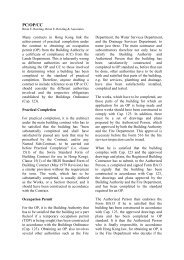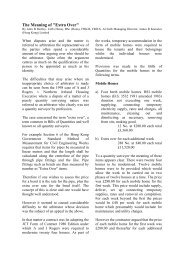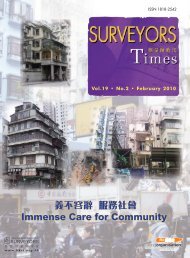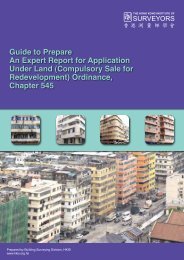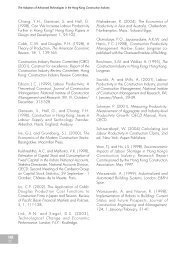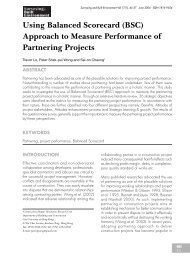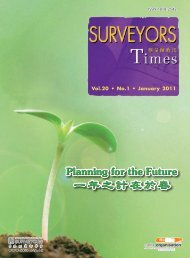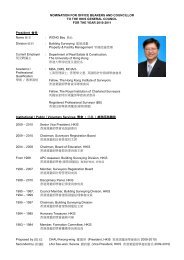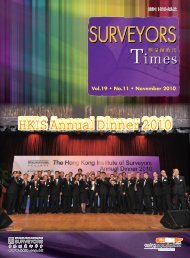Surveying & Built Environment Vol. 22 Issue 1 (December 2012)
Surveying & Built Environment Vol. 22 Issue 1 (December 2012)
Surveying & Built Environment Vol. 22 Issue 1 (December 2012)
You also want an ePaper? Increase the reach of your titles
YUMPU automatically turns print PDFs into web optimized ePapers that Google loves.
SBE<br />
26<br />
Reconstructing The Early History of the Gin Drinker’s Line from Archival Sources<br />
reservoirs and conduits are being<br />
constructed in the neighbourhood<br />
of Hong Kong in connection with<br />
the Shing Mun Valley water supply<br />
scheme, and lend themselves for<br />
incorporation in the defensive line.” 26<br />
In the report, the cost-effectiveness of<br />
the line became the main argument for<br />
its construction. In fact, as discussed<br />
below, the willingness of the British<br />
decision-makers to replace manpower<br />
with fortifications was the main reason<br />
for its construction.<br />
In March 1935, Major General<br />
Frederick Barron, the Inspector of<br />
Fixed Defences of the War Office,<br />
was sent to Hong Kong to inspect<br />
the proposed site of the Line. 27 When<br />
Barron arrived at Hong Kong, he noted<br />
that “platoon localities in two sectors<br />
have already been dug during the winter<br />
months, using military labour.” 28<br />
After inspection, Barron recommended<br />
the War Office to sanction the<br />
project. Six months later, the Chief<br />
of Imperial General Staff (CIGS)<br />
General Sir Archibald Montgomery-<br />
Massingberd submitted a report to the<br />
Defence Requirement Committee to<br />
secure a budget of £3,861,000 for the<br />
improvement of Hong Kong defences.<br />
The Line was surprisingly cheap<br />
compared to other installations. For<br />
example, an additional 9.2-inch gun<br />
cost £186,000, a new barracks for an<br />
infantry battalion £362,500, and the<br />
annual upkeep of an Indian infantry<br />
battalion was £78,000. However, the<br />
construction of the Gin Drinker’s<br />
Line cost only £168,000. Thus, it was<br />
hardly surprising that the War Office<br />
welcomed the project.<br />
dESIGN ANd lAYouT<br />
fRoM THE doCuMENTS<br />
Overall Planning<br />
The design of the Gin Drinker’s<br />
Line was done by the Hong Kong<br />
garrison led by Major General Arthur<br />
Bartholomew. Although the actual<br />
proposal sent by Bartholomew to<br />
the War Office has yet to be found,<br />
General Frederick Barron submitted<br />
a review of Bartholomew’s proposal,<br />
which contains much detail about the<br />
design and layout of the Gin Drinker’s<br />
Line. According to Barron’s Report,<br />
the defence of the Leased Territory<br />
contained three phases:<br />
1. Prevention of a landing within<br />
its boundaries<br />
2. Development of delaying action<br />
from either the frontier or the<br />
point of landing back to the final<br />
defensive position covering the<br />
vital areas<br />
3. The defence of the final<br />
defensive position 29<br />
As it was impossible to defend all<br />
26 Ibid., 9.<br />
27 “Mock Battle at Hong Kong,” 20/3/1935, The Straits Times; “10,000 Men in Secret Battle,” 9/4/1935,<br />
The Straits Times; “British Defences in Far East,” 18/4/1935, The Straits Times.<br />
28 WO 106/111, 19.<br />
29 “Report on the Defences of Hong Kong,” 4/1935, WO 106/111, 16.




